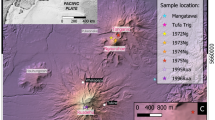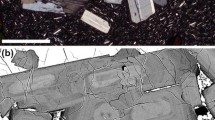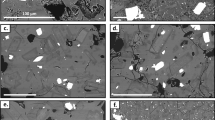Abstract
Under conditions of unobstructed diagenetic growth, opal-CT usually forms spherical aggregates, so-called “lepispheres”. From a scanning electron microscope study of deep-sea porcelanites, the development of these structures is described, from isolated opal-CT platelets via complete lepispheres to large coalescent aggregates. The conspicuous symmetric ultrastructure of lepispheres—reflected by the constancy of angles between interpenetrating crystal blades—is crystallographically determined: The lepispheres consist of groups of opal-CT blades intergrown according to the (30–34) and (10–16) twinning laws of tridymite. The same rules of intergrowth can be applied to the morphology of hydrothermally synthesized opal-CT lepispheres.
Similar content being viewed by others
References
Berger, W.H., Rad, U. von: Cretaceous and Cenozoic sediments from the Atlantic Ocean. Initial Reports Deep Sea Drilling Project 14, 787–954 (1972)
Calvert, S.E.: Composition and origin of North Atlantic deep sea cherts. Contrib. Mineral. Petrol. 33, 273–288 (1971)
Calvert, S.E.: Nature of silica phases in deep sea cherts of the North Atlantic. Nature Phys. Sci. 234, 133–134 (1971)
Flörke, O.W.: Zur Frage des „Hoch”-Cristobalit in Opalen, Bentoniten und Gläsern. Neues Jahrb. Mineral. Monatsh. 1955, 217–233 (1955)
Flörke, O.W.: Strukturanomalien bei Tridymit und Cristobalit. Ber. Deut. Keram. Ges. 32, 369–381 (1955)
Flörke, O.W.: Untersuchungen an amorphem und mikrokristallinem SiO2. Chem. Erde 22, 91–110 (1962)
Flörke, O.W.: Wachstum und Verzwillingung von Tridymit. Kristall u. Technik 1, 405–410 (1966)
Flörke, O.W.: Transport and deposition of SiO2 with H2O under supercritical conditions. Kristall u. Technik 7, 159–166 (1972)
Flörke, O.W., Jones, J.B., Segnit, E.R.: Opal-CT crystals. Neues Jahrb. Mineral. Monatsh. 1975, 369–377 (1975)
Hintze, C.: Handbuch der Mineralogie 1 (2), 1446–1462 (1915)
Jones, J.B., Segnit, E.R.: The nature of opal. 1. Nomenclature and constituent phases. J. Geol. Soc. Australia 18, 57–68 (1971)
Jones, J.B., Segnit, E.R.: Nomenclature and the structure of natural disordered (opaline) silica. Contrib. Mineral. Petrol. 51, 231–234 (1975)
Keene, J.B.: Cherts and porcellanites from the North Pacific, Deep Sea Drilling Project Leg 32. Initial Reports Deep Sea Drilling Project 32, 429–507 (1975)
Langer, K., Flörke, O.W.: Near infrared absorption spectra (4,000–9,000 cm−1) of opals and the role of “water” in these SiO2-nH2O minerals. Fortschr. Mineral. 52, 17–51 (1974)
LeClaire, L., Alcaydé, G., Froehlich, F.: La silification des craies: Rôle des sphérules de cristobalite-tridymite observées dans les craies des bassins océaniques et dans celles du Bassin de Paris. Compt. Rend., Sér. D 277, 2121–2124 (1973)
Oehler, J.H.: Tridymite-like crystals in cristobalitic “cherts”. Nature Phys. Sci. 241, 64–65 (1973)
Rad, U. von, Riech, V., Rösch, H.: Silica diagenesis in continental margin sediments off Northwest Africa. Initial Reports Deep Sea Drilling Project 41 (in press)
Rad, U. von, Rösch, H.: Mineralogy and origin of clay minerals, silica and authigenic silicates in Leg 14 sediments. Initial Reports Deep Sea Drilling Project 14, 727–751 (1972)
Rad, U. von, Rösch, H.: Petrography and diagenesis of deep sea cherts from the Central Atlantic. Spec. Publs. Internat. Ass. Sediment. 1, 327–347 (1974)
Segnit, E.R., Anderson, C.A., Jones, J.B.: A scanning microscope study of the morphology of opal. Search 1, 349–351 (1970)
Segnit, E.R., Jones, J.B., Anderson, C.A.: Opaline silicas from the Murray River region west of Wentworth, N.S.W., Australia. Mem. Natl. Museum Victoria 34, 187–194 (1973)
Weaver, F.M., Wise, S.W.: Ultramorphology of deep sea cristobalitic chert. Nature Phys. Sci. 237, 56–57 (1972)
Wilson, M.J., Russel, J.D., Tait, J.M.: A new interpretation of the structure of disordered alphacristobalite. Contrib. Mineral. Petrol. 47, 1–6 (1974)
Wise, S.W., Buie, B.F., Weaver, F.M.: Chemically precipitated cristobalite and the origin of chert. Eclogae. Geol. Helv. 65, 157–163 (1972)
Wise, S.W., Kelts, K.R.: Inferred diagenetic history of a weakly silicified deep sea chalk. Trans. Gulf-Coast Assoc. Geol. Soc. 22, 177–203 (1972)
Wise, S.W., Weaver, P.M.: Chertification of oceanic sediments. Spec. Publs. Internat. Ass. Sediment. 1, 301–326 (1974)
Author information
Authors and Affiliations
Rights and permissions
About this article
Cite this article
Flörke, O.W., Hollmann, R., von Rad, U. et al. Intergrowth and twinning in opal-CT lepispheres. Contrib. Mineral. Petrol. 58, 235–242 (1976). https://doi.org/10.1007/BF00402354
Received:
Accepted:
Issue Date:
DOI: https://doi.org/10.1007/BF00402354




